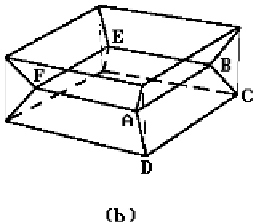Graphics Reference
In-Depth Information
a doughnut and a circle are similar because one can collapse the doughnut down to
a circle. A double doughnut (two doughnuts attached to each other along a disk) is
like a figure-eight curve. Therefore, since the circle is clearly a quite different shape
from a figure-eight, one can see that the more complicated solids to which they are
associated must also be fundamentally different shapes. This section is about a similar
idea, namely, to facilitate dealing with objects by representing them by simpler (lower-
dimensional) objects that nevertheless still capture the essence of the shape of the
original object. The idea of using a “skeleton” of an object as a shape descriptor goes
back to [Blum67] and [Blum73]. The fact that one gets a representation that has many
attractive features has led to quite a bit of research activity on this subject. It should
be noted, however, that the skeletal representation of an object is not a stand-alone
representation for objects in practice. Mostly, it is intended to be used in conjunction
with others, typically a boundary representation for continuous objects and a spatial
occupancy enumeration representation based on pixels or voxels for discrete objects.
Skeletons come in two flavors, namely, continuous and discrete. We shall begin
with definitions for the continuous case.
Definition.
Let
X
Õ
R
n
. A
maximal disk
in
X
is a closed disk
D
n
(
p
,r) contained in
X
with the property that it is not properly contained in any other closed disk in
X
.
Definition.
Let
X
Õ
R
n
. The
medial axis
(
MA
) or
skeleton
or
symmetric axis
of
X
is
the closure of the set of centers of maximal disks in
X
. The medial axis of a solid in
R
3
is sometimes called a
medial surface
. The real-valued function that assigns to each
center of a maximal disk in
X
the radius of that disk extends to a continuous func-
tion on the medial axis called the
radius function
of that medial axis.
Note.
Unfortunately, there is not complete agreement with regard to the terms
medial axis, skeleton, and symmetric axis in the literature. For example, the medial
axis in the continuous case is often also defined as the set of points equidistantly
closest to at least two points in the boundary. The advantage of the definition given
here with its closure condition is that if
X
is bounded then the medial axis will be a
compact set.
Figure 5.24 shows the medial axis (indicated by solid lines) of a planar L-shaped
bracket and a three-dimensional block. For a convex planar polygon it always con-
Figure 5.24.
Medial axes.




